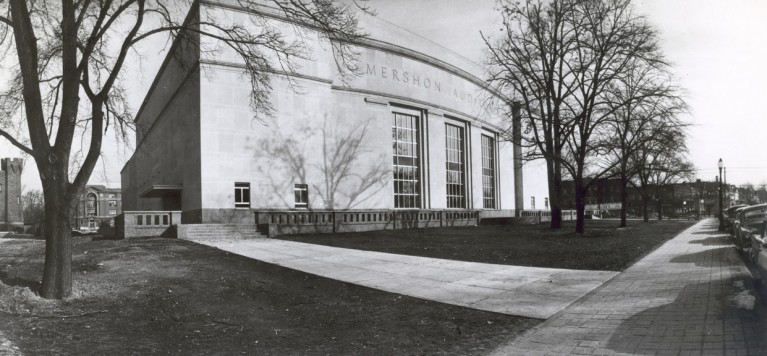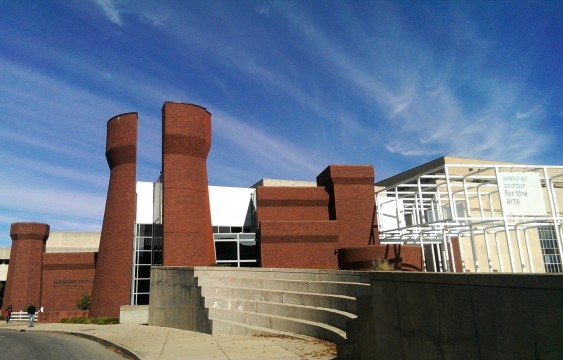Ohio State is moving forward on a major renovation of its arts district that would expand the Wexner Center for the Arts, Weigel Hall and move the Department of Theatre closer to High Street.
The university is also looking to remove the large concrete planters outside of the Wex, opening up the area from the Oval to High Street.
OSU Executive Vice President and Provost Joseph Steinmetz told The Lantern on Thursday that new construction would aim to update facilities for current academic needs.
“It’s been a while since we’ve addressed facilities for these departments, meaning that there’s some upgrades and changes and improvements that need to be made to match the great programs that we have,” he said.
The university put out a request for qualifications in late February for a $400,000 design contract.
OSU spokesman Gary Lewis said university officials will not publicly comment on specifics of that RFQ until its Thursday deadline has passed.
Plans for this project were first articulated under former President E. Gordon Gee’s administration in a university framework that envisioned concentrating different academic pursuits into geographical “gateways” around campus, with health sciences being further consolidated to the southwest section of main campus, engineering consolidated to the northwest, and the arts focused to the east, around the intersection of High Street and 15th Avenue.
Since taking over as president, Michael Drake has also expressed support for the proposal.
“We want to do things that make sense and make good sense and make good judgements and good decisions, but with that, having the arts be more concentrated on one part of the campus makes perfect sense to me,” he told The Lantern in January.
Steinmetz said the university’s arts community is also experiencing a cultural change as there is a growing tendency toward integration between traditional and contemporary arts.
After the RFQ deadline passes, the university will interview top candidates and expects planning on the overhaul — totaling $200 million — to run from May through November.
OSU plans to hire an architecture and design firm, as well as firms pertaining to mechanical, electrical, plumbing and civil engineering, landscape architecture and construction management.
In anticipation of construction, Steinmetz commissioned a steering committee in October for the district, chaired by arts and humanities divisional dean Mark Shanda. The committee submitted its proposals Feb. 25.
The committee echoed calls for a more open plaza on the front step of the Wexner Center, with its report requesting a “pulsing public gathering spot on par with Millennium Park in Chicago, the Pompidou Plaza in Paris, the Tate’s Turbine Hall in London or the steps of the Metropolitan Museum in New York.”
Department of Theatre
The Drake Performance and Event Center was built in 1972 and currently houses the Department of Theatre. That’s now set to change with plans to move the department to the arts district on High Street.
The steering committee has recommended four new performance spaces to facilitate the move: A 600-seat proscenium theater, a 250-seat thrust stage theater, a 125-seat black box theater and a 60-seat experimental venue. Dressing rooms, lighting and sound labs, five rehearsal spaces, more than 50 offices and storage are also proposed.
Placement of those theater facilities has not been publicly mapped out, and Steinmetz said the design process will give a clearer indication of plans.
“We can sit and, ourselves, speculate over what’s the best arrangement for performance spaces. What we’re looking for in that RFQ that went out is experts to come in and tell us that, ‘Given this is the mix of arts department you have currently, this is our best guess of how you can maximize the use … between departments.’ That’s precisely what we’re trying to get the RFQ process to address,” he said.
Mershon Auditorium
The future of Mershon Auditorium is uncertain. The university is considering remodeling it, although demolition was a leading plan as recently as 2010, when the framework suggested that “the possible removal of Mershon Auditorium would allow for significant expansion of the Wexner Center. The expansion would provide an active edge along the forum with a café, bookstore, gallery and the relocated cinema.”
Steinmetz said that while Mershon Auditorium is one of the few venues on campus that allows for large lectures, similar venues elsewhere reduce its necessity.
“We have a pretty vibrant performance scene downtown where we have places like the Ohio Theatre, the Palace Theatre, the Southern Theatre, just to name a few, that are getting increased use as things come into Columbus,” he said.
Depending on expectations of its future use in the new arts district, Steinmetz said the planning phase will “take a hard look” at Mershon to make a determination on the question of “should it stay or should it go.”
In the steering committee proposal, Shanda wrote that OSU should “bring the facility up to contemporary standards providing an additional 50 years of useful life.”
Steinmetz said part of the debate over Mershon is whether it serves the university’s academic purposes.
“These are academic departments, and not Broadway theater. In a dedication performance venue like the Palace and Southern theaters, shows come in and shows go out,” he said. “Academic performance spaces aren’t like that at all. What we need are performance space where students that are learning the craft of theater can have a production that is in its working phase and practice phase and rehearsal phase for several weeks.”
School of Music
The university will look to add an additional recital hall, and the steering committee recommended a venue that seats 280 people. Two large rehearsal studios for orchestral and large choral groups are also being considered. The university also plans to improve the acoustics and lighting of Weigel Auditorium and looks to renovate Hughes Hall with new teaching studios and offices.
Wexner Center for the Arts
OSU is also considering adding a new 70-to-100-seat screening space and relocating the current Film/Video Theater to pave the way for a plaza renovation that would create a pedestrian square outside the building.
The steering committee has recommended a new 600-seat black box theater with a standing capacity of 1,200 people. An additional 10,000-to-12,000-square feet of gallery space is also on the table.
It’s possible that the Heirloom Café and the bookstore will be relocated to increase their visibility, too. A 2012 strategic plan for the College of Arts and Sciences noted a need to “improve the working relationship with the Wexner Center to include: improved access to Mershon Auditorium, access and integration of the Wexner Media Arts.”
Moving Image Production
The university has expanded its academics for moving image production, and it is now also looking to expand relevant facilities and equipment. In particular, the university called for classroom editing, sound instruction rooms and a sound stage.
Steinmetz said the trend toward integrated arts does not require a large expansion in facilities, but state-of-the-art equipment is needed for specific technology needs.







